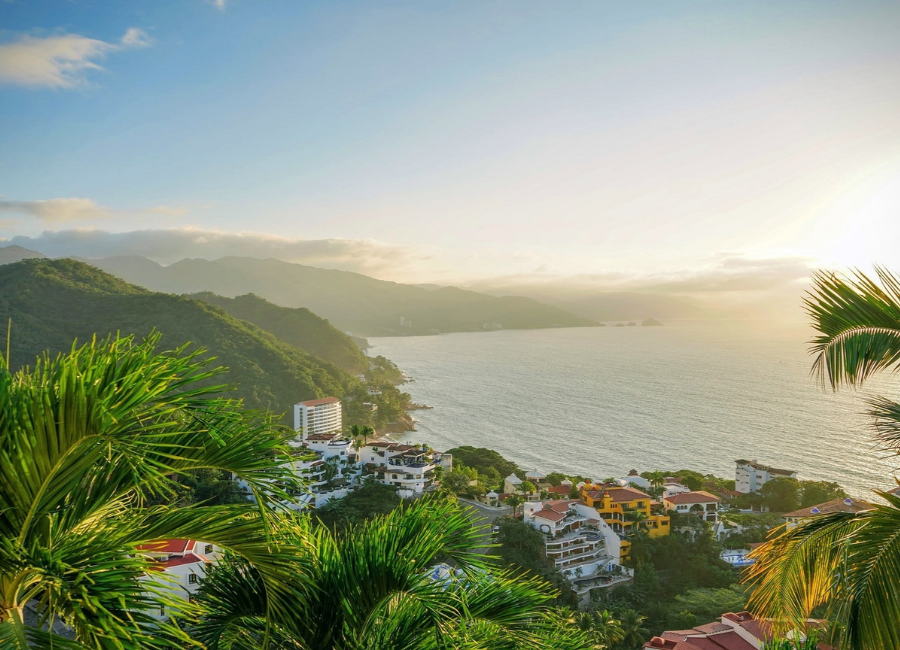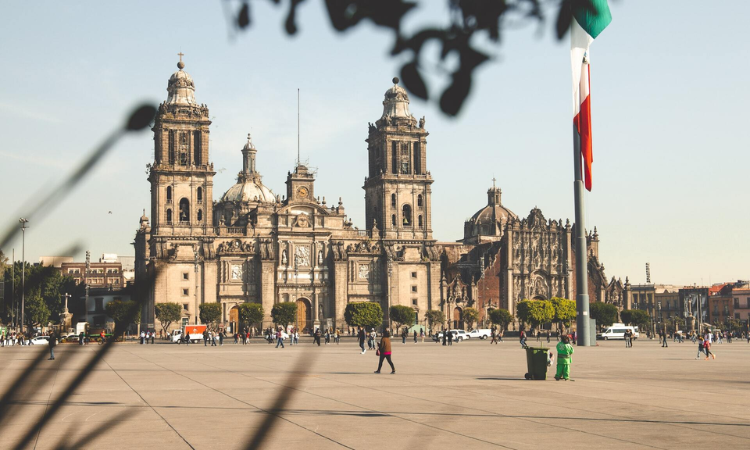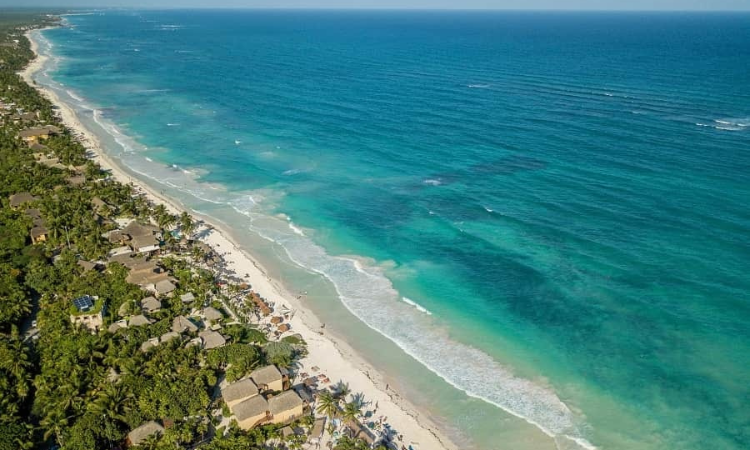The birthplace of tacos, Aztec heritage, iconic sombreros, and tequila, Mexico enjoys a global reputation.
Its diverse landscapes encompass the glistening azure shores of Baja California, the arid deserts of the north adorned with cacti, the tranquil Maya communities, and palm-fringed southern beaches. Mexico invites you to scale volcanoes, witness majestic whales, and explore agave farms. Scattered across the country, you’ll encounter ornate colonial churches, colossal pyramids, and a refined culinary scene. Prepare for your Mexican adventure by perusing our comprehensive guide with travelling to Mexico tips.
Understanding Mexico’s Currency: How Much is a Dollar in Mexico?
1. Introduction to Mexican Pesos
Mexico’s official currency is the Mexican Peso (MXN). Understanding its value and how it compares to your home currency is essential for a smooth trip. While prices vary across the country, knowing the approximate exchange rate can help you budget effectively. As per current rate $1=18.31 Mexican Pesos.
Tips on Using Credit Cards and When to Withdraw Money
In many tourist destinations and urban areas, credit cards are widely accepted. However, it’s advisable to carry some cash for smaller establishments or in remote regions. Carrying cash is one of the most important tips for travelling to Mexico. ATMs are readily available, and it’s often best to withdraw pesos locally to get a favorable rate. Just make sure to notify your bank about your travel plans to avoid any issues with your cards abroad.
2. The Importance of Checking Conversion Rates and Where to Get the Best Deals
Checking daily exchange rates can save you money. Currency exchange bureaus, banks, and even some hotels offer conversion services. It’s wise to explore options for the best deal, considering the current market rate. Armed with knowledge about the Mexican Peso, smart credit card usage, and a quest for optimal conversion rates, you can fully enjoy your Mexico journey, easing currency-related concerns.
Age Regulations: What is the Drinking Age in Mexico?
1. Overview of Age Restrictions
Mexico has different age restrictions for various activities, and it’s important to be aware of them:
- Drinking Age: The legal drinking age in Mexico is 18. It’s strictly enforced, and bars, clubs, and stores selling alcohol will often check for identification.
- Smoking Age: The legal age to purchase and consume tobacco products is 18.
- Voting Age: The voting age in Mexico is 18, the same as the drinking and smoking age.
- Age of Majority: In Mexico, the age of majority is 18, which means individuals of this age and older have legal autonomy.
2. Tips for Young Travelers Regarding Safety and Enjoying Mexico Responsibly
If you’re a young traveler visiting Mexico, it’s essential to prioritize safety and enjoy your trip responsibly:
- Respect Local Laws: Adhere to Mexico’s legal drinking age and other age-related regulations.
- Travel in Groups: When exploring nightlife or unfamiliar areas, it’s safer to travel with a group of friends.
- Don’t Drink and Drive: Mexico has strict laws against drinking and driving. Use designated drivers, public transportation, or taxis.
- Be Mindful of Your Belongings: Keep an eye on your belongings and avoid leaving them unattended.
- Learn Basic Phrases: Knowing some basic Spanish phrases can be helpful, especially in emergencies.
By being aware of age restrictions and following these safety tips, young travelers can have a fantastic and responsible experience while exploring Mexico.
Must-Visit Spots: What is Mexico Known For?
The Magic of Mexico City
Mexico City, boasting a population of over 20 million, is a vibrant metropolis brimming with diverse attractions. From its historic heart at Zocalo, where remnants of the ancient Aztec city, Tenochtitlan, blend with the grandeur of the Palacio Nacional, to the colossal Pyramids of Teotihuacán located just an hour north of the city, there’s an array of historical and cultural sites to explore. Be sure to savor the iconic Tacos al pastor, a delectable fusion of Lebanese and Mexican flavors, with options both with and without pineapple. Don’t miss a visit to the renowned Museo Nacional de Antropología, providing profound insights into the nation’s history and indigenous cultures. Seeking respite? Chapultepec Park, the largest city park in the Western Hemisphere, offers a wide range of activities. Immerse yourself in the Folkloric Ballet, a captivating showcase of Mexico’s diverse dances. To delve into the life of renowned artist Frida Kahlo, visit the Museo Frida Kahlo, and for more artistic insight, explore the Anahuacalli Museum. In Xochimilco, the colorful trajineras offer a journey into the city’s pre-Hispanic legacy, set amid the charming backdrop of Lake Xochimilco’s chinampas. And, of course, embark on a culinary adventure, as Mexico City’s food scene has garnered international acclaim. Finally, experience the thrilling lucha libre wrestling, an entertaining local pastime that takes place at Arena México, where masked heroes grapple in a circus-like atmosphere. Mexico tours are incomplete without exploring this charming city.
Exploring Beaches in Playa del Carmen and Puerto Vallarta
Playa del Carmen offers a plethora of activities for nature and adventure enthusiasts. Delve into underground explorations through ancient caves with pristine rivers and magnificent stalactite formations, providing a glimpse into a world millions of years old. The region is famed for its cenotes, numbering over 2,500, where you can partake in snorkeling, diving, or swimming in these mystical underground caves believed to be the entrance to the Mayan underworld, Xibalbá. In close proximity to Playa del Carmen, you’ll find various archaeological sites like Muyil, Cobá, and Tulum, ideal for half-day tours. Spend your days relaxing at luxurious hotel spas or basking in the warm, tranquil waters along picturesque beaches that grace postcards. Most beachfront hotels offer an array of aquatic activities, from snorkeling and boat tours to paddleboarding and kayaking, ensuring a delightful beach experience even for those not lodging directly on the shoreline.
Puerto Vallarta, often affectionately referred to as “Vallarta” or “PV,” offers more than the typical coastal resort experience. Despite its breathtaking oceanfront, this charming town maintains a small-town ambiance while showcasing some of Mexico’s most distinctive and sophisticated seaside offerings. The dining establishments and lodging options seamlessly blend refinement with efficiency, creating a harmonious experience within the hotel and restaurant precincts.
While many people associate this picturesque locale with its natural boundaries, such as the meandering Banderas Bay along the coast or the majestic Sierra Madre mountains gracing the east, Puerto Vallarta has much more to offer. Take the opportunity to explore its unique facets by indulging in delectable cuisine, uncovering hidden gems in the Zona Romantica, savoring signature cocktails at beachside bars along the Malecón, or dancing to the rhythmic beats of salsa in a Havana-style nightclub.
The Charm of San Miguel de Allende
San Miguel de Allende is a captivating Mexican small town, but it’s more than that – it’s a vibrant colonial-style city with a thriving wine culture, bustling markets, and an impressive culinary scene. Its heart is adorned by the iconic Parroquia de San Miguel Arcángel, a magnificent pink structure that dominates the Spanish-style architecture surrounding it. The town offers an array of museums, diverse boutiques crafting everything from T-shirts to silver jewelry, and an eclectic culinary landscape, spanning from shrimp tempura to barbacoa to intriguing Sri Lankan-Swiss-Mexican fusion. Despite its size, San Miguel boasts a wealth of activities, making it perfect for both day trips and extended visits, featuring art exhibitions and lively music performances as the sun sets.
The Rich History of the Yucatan Peninsula
The Yucatan Peninsula, located in southeastern Mexico, boasts a rich history, breathtaking landscapes, and a distinct culture shaped by the ancient Maya civilization, which has left behind remarkable archaeological sites. Notably, Chichen Itza stands out as one of the most renowned Maya sites, featuring the iconic El Castillo pyramid and holding UNESCO World Heritage status. Uxmal, another prominent Maya city, is celebrated for its intricate architectural designs and the notable Governor’s Palace. Those intrigued by ancient astronomy should explore Mayapan, a site that houses a unique observatory known as the House of the Doves. Adding to the region’s allure, Merida, the capital of Yucatan, thrives as a lively city marked by a blend of colonial and Mayan influences. Its grand avenue, Paseo de Montejo, is graced with historic mansions, shops, and restaurants, enhancing the city’s vibrancy.
Dive into the Mayan Ruins and Other Archaeological Sites
Mexico’s history spans millennia, and the prominent Maya civilization, extending from southern Mexico to Guatemala, Belize, Honduras, and El Salvador, crafted impressive cities and displayed prowess in mathematics, astronomy, art, and agriculture. While remnants of this culture thrive in remote Mexican communities, famous Mayan cities like Chichen Itza and Tulum have garnered attention. But hidden in Mexico’s southern states of Quintana Roo, Yucatan, Campeche, Chiapas, and Tabasco, there are more Mayan ruins to explore. From Chichen Itza’s mathematically precise El Castillo pyramid to Tulum’s coastal ruins overlooking the Caribbean Sea, and the lesser-known Coba, Palenque, Calakmul, Bonampak, and Ek’ Balam, each site offers unique insights into Mayan culture and history.
The Serenity of the Pacific Coast and the Vibrant Life of the Caribbean Coast
Mexico’s coastline offers diverse experiences. On the Pacific Coast, destinations like Zihuatanejo and Acapulco offer a mix of tranquil beaches and lively entertainment. The Marietas Islands offer a tranquil retreat ideal for snorkeling and bird-watching enthusiasts. Along the Caribbean Coast, you’ll find stunning turquoise waters teeming with vibrant marine life. Cancun, a renowned resort city, boasts beautiful beaches, a bustling nightlife, and easy access to the nearby Tulum ruins. For avid scuba divers, Cozumel stands out with its famed coral reefs. As mentioned previously, Playa del Carmen, a delightful coastal town, seamlessly combines beachside relaxation with vibrant nightlife.
Whether you’re seeking relaxation on the beach, a journey through history, or the vibrancy of a bustling city, Mexico’s diverse offerings make it a captivating destination for every traveler. From ancient ruins to pristine beaches and cultural gems, this country has it all, ensuring that your visit will be an unforgettable experience.
Safety Concerns: How Safe is it to Travel to Mexico?
Mexico is a diverse and culturally rich country known for its stunning landscapes, historic sites, and vibrant cities. While it is a popular tourist destination, safety concerns often come to mind. In this guide of travelling to Mexico tips, here’s what you need to know about safety when traveling to Mexico:
1. Common Misconceptions About Safety in Mexico:
- Violence and Safety: Mexico’s vast size and regional diversity mean that safety conditions can vary. While some areas experience drug-related violence, many popular tourist destinations are safe and welcoming to visitors.
- Travel Warnings: Pay attention to travel advisories from your government, but also consider that these warnings often focus on specific regions where criminal activities are more concentrated. Many areas popular with tourists remain safe.
- Local vs. Tourist Safety: Criminal activity tends to target locals more than tourists. However, it’s essential to stay aware of your surroundings, just as you would when traveling anywhere.
2. Mexico Safety Tips and Things to Know Before Your Trip:
- Research Your Destination: Research the specific region or city you plan to visit. Get to know its safety situation, attractions, and local customs.
- Stay Informed: Keep up with the latest news and safety updates for your destination. Be aware of any local events or festivals that could affect your plans.
- Travel Insurance: Purchase comprehensive travel insurance that covers medical emergencies and trip cancellations. This is a vital safety net for any traveler.
- Secure Your Belongings: Petty theft can occur, especially in crowded areas. Keep your valuables secure and avoid displaying expensive items.
- Emergency Numbers: Know the local emergency numbers, such as those for the police, fire department, and medical services.
3. Tap Water in Mexico: Is it Safe to Drink? Alternatives to Tap Water:
Tap water safety varies by region in Mexico. In some places in Mexico, it’s safe to drink, while in others, it’s not. To ensure your health, consider the following:
- Bottled Water: The safest option is to drink bottled water. It’s widely available and affordable.
- Filtered Water: Some hotels and restaurants use filtered water to serve guests. You can ask if the water has been purified.
- Boiling Water: If you’re in a remote area, boiling tap water for at least one minute can make it safe to drink.
- Water Purification Tablets or Devices: Portable water filters and purification tablets can be handy for travelers who want to reduce plastic waste and have access to clean drinking water.
4. Interacting with Locals: Do I Need to Speak Spanish?
While knowing some Spanish is helpful, it’s not a strict requirement for traveling in Mexico. Here’s what you should know about language:
- Basic Phrases: Learning a few basic Spanish phrases can enhance your travel experience and help you interact with locals. Phrases like “hello,” “thank you,” and “please” can go a long way.
- English Proficiency: In tourist areas and major cities, you’ll often find people who speak English, especially in hotels and restaurants. However, speaking some Spanish can be advantageous in smaller towns and local markets.
- Translation Apps: Consider using translation apps or carrying a pocket dictionary to facilitate communication when needed.
Remember that Mexicans appreciate visitors who make an effort to respect their language and culture. While it’s possible to navigate Mexico with limited Spanish, knowing some basics can enhance your trip and interactions with the local community.
Navigating Through Mexico: A Comprehensive Guide
When exploring the diverse landscapes and vibrant culture of Mexico, it’s essential to understand the best ways to navigate through the country, whether you’re in bustling cities or remote regions. Here’s a comprehensive guide to help you travel safely and efficiently:
1. Modes of Transportation:
Mexico offers various modes of transportation to suit your travel preferences and destinations:
● Buses: Mexico boasts an extensive and affordable bus network. Luxury buses are available for long journeys, while local buses provide access to smaller towns and rural areas.
● Trains: Although train travel in Mexico is limited compared to buses, the Chihuahua-Pacific Railway, also known as “El Chepe,” offers a spectacular route through Copper Canyon.
● Domestic Flights: When traveling long distances, domestic flights can save time. Major cities have well-connected airports.
● Renting a Car: For exploring remote areas and enjoying road trip adventures, car rental can be a fantastic option. Be sure to have comprehensive car insurance, follow traffic rules, and choose well-maintained roads that are covered by the rental car. Rent a car only from reputable car rental companies, with good online reviews.
2. Taxis and Ride-Sharing:
● Taxis: Taxis are a common means of transportation in Mexican cities. Ensure you only use authorized taxis, which are typically labeled with official logos. Negotiate fares before starting your journey or request the driver to use the meter.
● Ride-Sharing Apps: Apps like Uber are available in many Mexican cities and can be a more convenient and transparent option for getting around.
3. Credit Cards vs. Cash:
● Credit Cards: In major tourist areas and cities, credit cards are widely accepted. However, in more remote or rural regions, it’s advisable to carry cash.
● ATMs: ATMs are readily available in urban areas, making it convenient to withdraw local currency. Beware of withdrawal fees, and notify your bank of your travel plans to avoid card issues.
4. Mexico’s Diverse Regions:
● Baja California: This northern region, known for its stunning landscapes and coastal beauty, offers outdoor adventures like no other. Whether you’re into whale watching, surfing, or exploring vineyards, Baja California has something for everyone.
● Mexico’s Cities: The country’s cities, such as Mexico City, Guadalajara, and Oaxaca, are cultural hubs with vibrant art scenes, historic sites, and culinary delights. Be sure to explore local markets, museums, and try authentic Mexican cuisine.
● Colonial Towns: Mexico boasts a wealth of well-preserved colonial towns like San Miguel de Allende, Guanajuato, and Morelia, where you can immerse yourself in history, art, and tradition.
● Beach Destinations: Mexico’s coasts, including Cancún, Puerto Vallarta, and Playa del Carmen, are world-renowned for their beautiful beaches, water activities, and lively nightlife.
While navigating through Mexico, understanding the transportation options, embracing the local culture, and respecting the local currency preferences will enhance your travel experience. Whether you’re exploring cities, embarking on a road trip, or relaxing on the beaches, Mexico offers an array of captivating experiences for every type of traveler.
Embarking on Culinary Adventures in Mexico
When journeying through Mexico, one of the most captivating experiences lies in exploring the country’s diverse culinary landscape, which encompasses the irresistible offerings of street food vendors to the exquisite creations of top-tier restaurants. This guide is your ticket to savoring a delectable voyage through Mexican cuisine:
1. Exploring the Rich Flavors of Mexico:
● Street Food: Mexican street food is a multisensory delight. As you wander through taco stands and bustling markets, you’ll encounter a myriad of delectable and budget-friendly choices. One of the best things you can do to experience the authentic culture is to try classics like tacos al pastor, elotes (grilled corn on the cob), tamales, and churros.
● Traditional Markets: Local markets provide an authentic window into Mexican daily life. They serve as ideal places to sample street food, savor freshly made tortillas, discover exotic fruits, and explore artisanal goods.
● High-End Restaurants: Mexico boasts a burgeoning high-end dining scene, with cities such as Mexico City, Oaxaca, and Puebla hosting award-winning establishments that seamlessly blend traditional recipes with contemporary culinary techniques. Reserving a table at these popular venues is highly recommended.
2. Must-Try Culinary Delights and Beverages:
● Tacos: Tacos are an integral part of Mexican cuisine, offering a myriad of mouthwatering variations. Delight your taste buds with tacos al pastor (marinated pork), barbacoa (slow-cooked meat), and tacos de pescado (fish tacos).
● Mole: Mole is a sumptuous and intricate sauce frequently served over chicken or turkey. Each region in Mexico boasts its own unique mole recipe, contributing to the country’s culinary diversity.
● Ceviche: Along the coastal regions, relish fresh ceviche, a dish crafted from marinated seafood, typically shrimp or fish, enhanced with zesty lime, chili, and aromatic cilantro.
● Mezcal and Tequila: A journey through Mexico is incomplete without a sampling of its world-renowned spirits. Mezcal, characterized by its smoky agave essence, has gained immense popularity, while tequila remains an enduring classic. Don’t miss the opportunity to visit a local distillery for an authentic tasting experience.
● Aguas Frescas: On warm days, these refreshing beverages provide the perfect thirst-quenching solution. From traditional horchata, a rice-based drink, to a variety of tropical fruit flavors, aguas frescas offer a vibrant spectrum of choices.
3. Ensuring Safety in Culinary Exploration:
● Hygiene: When indulging in street food, it’s advisable to choose vendors with bustling stalls, indicating a high turnover of fresh ingredients. Vendors who prepare food in front of you are also a reliable choice.
● Water: While the safety of tap water varies by region, it’s generally recommended to opt for bottled water to stay hydrated. Caution is advised, especially in smaller towns or rural areas where sometimes water is not safe to drink.
● Ice: When ordering chilled beverages, confirm the source of the ice used. Many establishments use purified ice, but it’s prudent to double-check.
Venturing into Mexican cuisine, you embark on a gastronomic adventure brimming with an orchestra of flavors, fragrances, and traditions. Whether you’re savoring beloved street food classics or indulging in gourmet masterpieces, Mexican culinary offerings are certain to leave you yearning for more. Embrace your adventurous palate, prioritize hygiene, and, above all, relish each and every bite throughout this extraordinary culinary odyssey.
Finding the Ideal Time for Your Mexican Adventure
When to explore Mexico is one of the most important travelling to Mexico Tips.
a. Weather Conditions
Dry Season (November to April)
● This period marks the high tourist season, particularly in coastal areas like Playa del Carmen, Puerto Vallarta, and the Yucatan Peninsula.
● Expect warm and pleasant weather with minimal rainfall.
● Ideal for indulging in beach activities, exploring archaeological wonders, and participating in outdoor events.
Rainy Season (May to October)
● During this period, many parts of Mexico witness afternoon showers, although mornings usually remain sunny.
● The Pacific Coast may experience heavier rains, while the Caribbean Coast might have intermittent showers.
● Fewer tourists mean fewer crowds and sometimes more budget-friendly options.
b. Festivals and Events
● Dia de los Muertos (Day of the Dead): Celebrated from October 31 to November 2, this vibrant festival transforms towns and cities with colorful parades, intricate altars, and traditional dances.
● Independence Day: Held on September 16, this day brims with national pride, featuring parades, fireworks, and festivities.
● Semana Santa (Holy Week): This religious festival leading up to Easter includes processions, re-enactments, and special masses.
c. Regional Considerations
● Beach Resorts: Popular destinations such as Cancun, Puerto Vallarta, and Playa del Carmen shine during the dry season. Consider visiting during the shoulder months of the rainy season to avoid crowds and secure better deals.
● Central Mexico and Mexico City: Cities like Mexico City maintain relatively consistent climates. Winter months can be cooler, so packing some light layers is advisable.
● Baja California: Plan your visit between January and March for whale watching, as gray whales migrate to the warm waters during this period.
d. Budget Considerations
● The dry season signifies the peak tourist season, often resulting in higher prices.
● The rainy season offers an opportunity to save money on accommodations and tours due to reduced demand.
By carefully considering the weather, regional characteristics, and festivals, you can ensure your trip to Mexico aligns with your preferences and expectations, allowing you to make the most of this enchanting country.
Embrace the Magic of Mexico
As you conclude your journey through this travelling to Mexico tips guide, take a moment to reflect on the beauty and diversity that awaits you in Mexico. This extraordinary country beckons with open arms, offering a kaleidoscope of experiences that can leave you in awe.
A Land of Rich Contrasts:
From the golden beaches along the Pacific and Caribbean coasts to the dramatic canyons and arid deserts of the interior, Mexico unveils a tapestry of landscapes and cultures that captivate the soul. The ancient Maya and Aztec civilizations have left their mark in the form of stunning archaeological sites, while vibrant cities like Mexico City pulse with modern energy.
Mexico Travel Tips:
Throughout this guide, you’ve gained invaluable insights to ensure your journey is not just memorable but also enriching. You’ve learned about navigating through diverse terrains, respecting local customs, and savoring the sumptuous flavors of Mexican cuisine. Remember the importance of staying safe, respecting the environment, and cherishing every moment of your adventure.
Venture Beyond the Usual:
While Mexico’s renowned destinations like Cancun, Tulum, and Mexico City beckon with their allure, the true magic often resides off the beaten path. Challenge yourself to explore the hidden gems, the remote villages, and the untouched natural wonders. It is in these uncharted territories that you can immerse yourself in the authentic Mexican experience and connect with the heart and soul of this remarkable nation.
Want to plan a trip to Mexico? Check out our Mexico tours or reach out to us and our experts will be happy to help.
Read our blogs related to Mexico to know more about the enchanting country.
● Why travel to Mexico?
● Celebrate Mexico’s Spring Equinox In These Ancient Sites
 Toll Free (USA & Canada) +1 866 978 2997
Toll Free (USA & Canada) +1 866 978 2997








